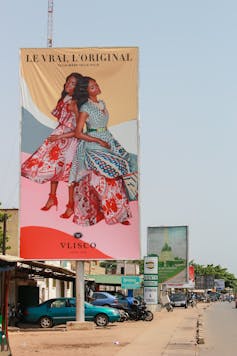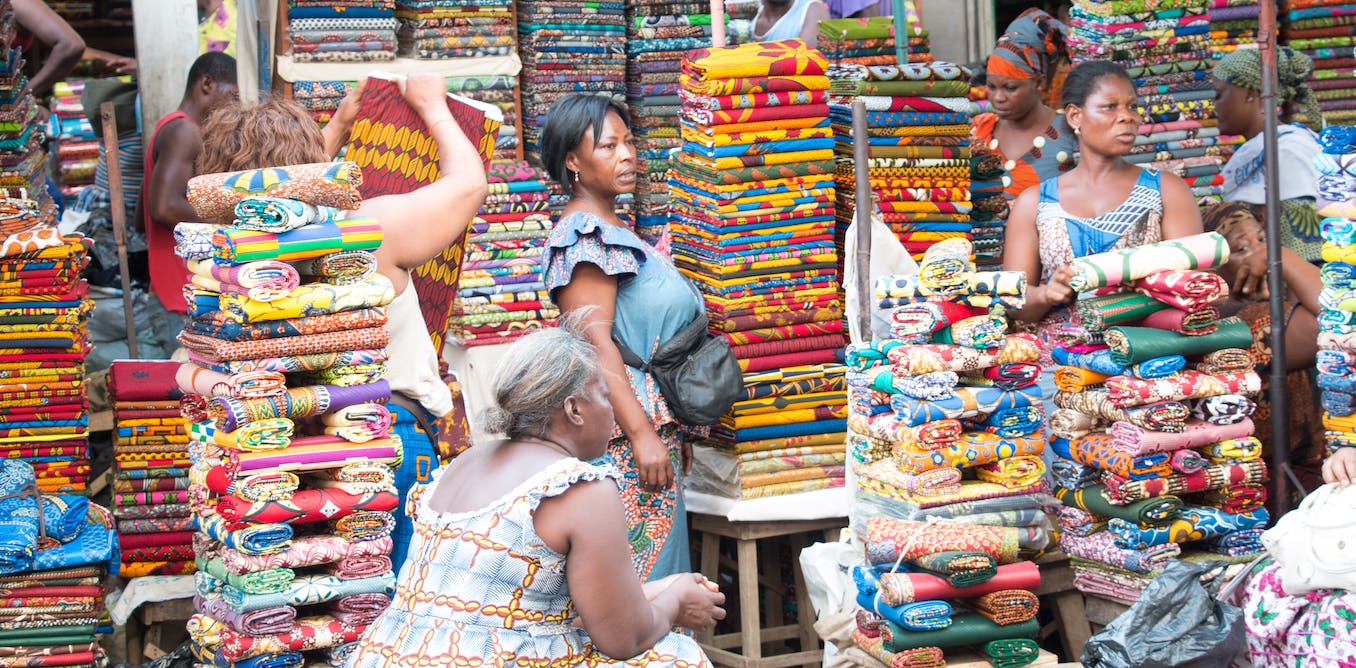West Africans ditch Dutch wax prints for Chinese ‘real-fakes’
Since the early 20th century, Vlisco has produced African print cloth – otherwise known as Dutch wax prints. This vibrantly coloured and intricately patterned fabric dominates West African markets and is globally recognised as quintessentially “African”.
Ironically, this iconic bold cloth was originally forged by Dutch colonial companies attempting to mechanically reproduce handmade Javanese batik cloth. When this failed to take off in Southeast Asia, Dutch traders began to sell the cloth in West African markets. The patterns were modified to fit local tastes and quickly became popular.
The rise of mass-produced, Dutch wax prints partially displaced domestic textiles, which lacked the colourfastness and material lightness that ultimately made wax prints an essential everyday consumer good.
But this is not where the story ends. Today, the majority of Dutch designs available on African markets are low-cost reproductions made in China. The entry of these Chinese textiles has upset Dutch and local producers of “authentic” wax prints.
These producers are trying to protect their hold on the market by appealing to ideas of “originality” and legal notions of “authenticity”. But consumers are more interested in the quality and look of the cloth, and the way it reflects the wearer’s taste and status.
New market players undercut originals
Hitarget is the market leader among Chinese upstart brands. It is a thorn in the side of a number of competitors. These include the Dutch company Vlisco as well as the Nigeria and Ghana-based manufacturers of popular African print brands like GTP, ATL, ABC, Nichemtex or Uniwax. The majority of Hitarget patterns are “original” Dutch designs to which Vlisco claims legal and technical rights.

Koko Masseme
Over the past decade, Vlisco has repeatedly taken legal action by seizing counterfeit cloth. This strategy has had limited results.
More recently, the company has adopted an alternative, equally ineffective, response to the issue. In September 2014, Vlisco launched a major brand protection campaign in its African fashion markets, entitled Connoisseurs of Style.
The Vlisco Connoisseurs of Style web guide is designed to help female consumers identify the brand’s markers of authenticity. These include a trademarked monogram, an encrypted bar code, a label, a design number, and the word marks “Guaranteed Dutch Wax Vlisco/Véritable Wax Hollandais Vlisco” printed on the cloth’s selvedge.
These signs mark the fabric as authentic according to the legal regimes that underpin the ideas of originality and brand ownership. But on the ground, attitudes towards authenticity are quite different.
Consumer standards and attitudes
In my research in Lomé (Togo), once the largest textile market for Dutch wax prints in West Africa, I found that consumer evaluations of copies rarely match legal evaluations. Copies are technically pirates according to International Property law. But to buyers they can be both authentic and inauthentic, real and fake.
As anthropologist Elizabeth Vann notes in her work on Vietnamese real-fake goods, the categories of brand ownership and the intellectual property rules that uphold them cannot be taken for granted everywhere.
Just like consumers of the global North, Togolese desire affordable goods and willingly buy copies and counterfeits. Some copies have become investment pieces that generate sensations of desire and pride and necessitate cultural expertise to successfully choose and purchase.
Others, however, are considered faux or bad and are not valued as highly. Good copies do not betray consumers, whereas bad or fake copies have the power to expose the unsavvy.
Instead of relying on labels and techno-signs of authenticity as per the Vlisco style guide, Togolese turn to the cloth’s material properties to establish its worth. Value is ascribed through the senses, by touching, smelling or even tasting the cloth.
Hitarget has become especially popular among younger consumers due to its affordability and high-quality thread count, colour palette, and design precision. Expert fashionistas can distinguish Hitarget from Vlisco by mere sight. Some even consider Hitarget to be “better” than the “authentic” print.
Even more amazing is the fact that Hitarget has recently also fallen victim to counterfeiting, making the distinction between real copies and real-fake even more challenging.
In Togo, societal norms of ascribing value to fakes and copies are at odds with global regulatory regimes that are based on a specific proprietary relationship between authorship and ownership.
Roots of intellectual property
In a world where most things are produced with some level of human collaboration, intellectual property law inevitably raises complex questions about what constitutes “authorship” and “invention”.
Intellectual property law essentially manages the slippery tension between private ownership and the public domain – the “commons”. It does this by granting temporary private ownership rights for a fixed term, after which the rights fall back into the public domain.
Copyrights, patents and trademarks – the basic tools of intellectual property law – are firmly rooted in 18th-century liberal thought. Rights were created to manage the conversion of ideas into property – with accompanying rights that could be protected, licensed, and ultimately turned into money.
Not surprisingly, to secure financial returns corporations push for extended rights of intellectual property so that their inventions, words and trademarks can be asserted and licensed as legal rights. It is in this way that they are converted into profits in competitive global markets.
They may also, as Vlisco did, create new markers of authenticity so that their intellectual property claims are recognised by consumers.
The historical twists and turns in the European and Chinese reproduction of African print cloth challenges the very idea and practice of intellectual property rights. After all, who legitimately creates and who illegitimately appropriates?
